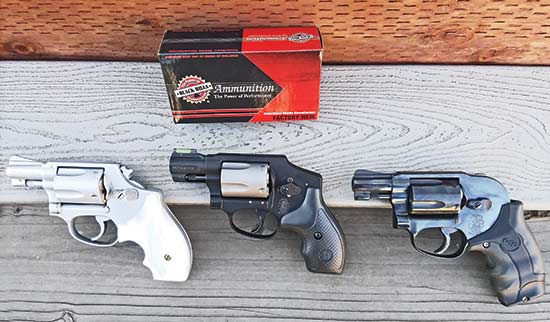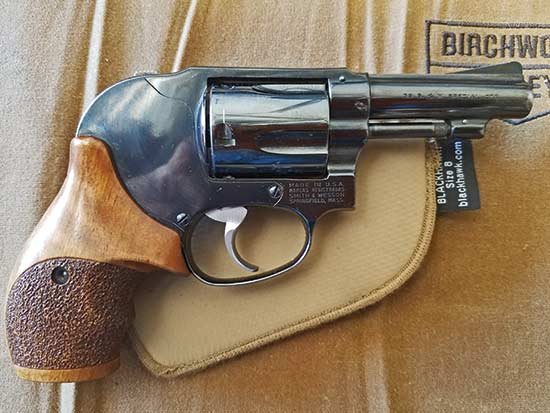A Slicker Snubbie
Part 1: Turn Your S&W J-frame Into A “J-Plus.”
After a lifetime of shooting medium and large-frame revolvers, developing a crush on S&W J-Frames late in life brings with it a steep learning curve. A J-Frame is a beautiful thing, but is less forgiving of shooter error than, say, a 6-inch Model 14 K-Frame. Tons of practice can overcome it, but some alterations and/or additions to the revered Snubbie Platform can help. So without further adieu, let’s examine a few.

S&W’s J-Frame model numbers and options come and go, but the 3 main types are typified by (left to right) the:
M60 exposed hammer (although the spur has been bobbed here), M340PD “hammerless” Centennial-style, and the
M49 Bodyguard with a shrouded-but-thumb-cockable hammer. The 340PD sports factory synthetic stocks. The M49
has Crimson Trace LaserGrips. The M60? Eagle Grip’s Secret Service-pattern polymer “mother-of-pearl.”
Springs and Sight Radius
The sight radius on a 2-inch J-Frame means you really should do everything you can to “cheat.” Replacing the trigger return spring can really improve the double-action pull, but if you go too low on the poundage it can cause trigger return issues. As far as mainspring replacement, well, as Elmer Fudd might say, “be vewy, vewy careful” about going too light there as well. Your CCW snubbie is not the gun you want to have primer poppin’ issues with.
We got a set of trigger return springs from Brownells as well as some replacement mainsprings from Wolff. On one M49 we left things alone, but for another we lapped the trigger return spring block and swapped out the stock 15-pound spring for a 13 pounder. It made the trigger a lot smoother and ignition was still 100 percent. Another “customy” touch? We replaced the original narrow, grooved trigger with a slightly broader smooth-faced one, which my shooting buddy Thomas Mackie just happened to have floating around in a spare parts bag. This made things even sweeter.
An Extra Inch
Another way to cut down the difficulty of shooting a 2-inch gun is to simply find a model variant with a 3-inch barrel. That extra inch of sight radius helps a lot, not to mention the velocity enhancement (with select loads) a 3-inch has over a 2. Want an example? We found Black Hills 125-grain +P JHP to average 867 fps from a 2-inch Model 60 and 953 fps from a 3-inch Model 36. But be that as it may, most serious J-Frame packers go for the 2 inch.
One thing we learned: Learning to shoot a 2-inch well requires practice. It’s kinda funny how guys will shoot the living hell out of their nice adjustable-sighted, 4- or 6-inch K- or L-Frames when those will likely not be the Smith they’ll have on them in an emergency. And that may be one reason I finally decided to start seriously fooling with J-Frames.
Unless you’re contemplating using a snubbie in Slowfire Bull’s-eye Competition, any J-Frame is—for all practical purposes—“double-action-only” despite the mechanical specifics of action type. Of course, lacking the courage of my convictions I simply can’t jettison the single-action option totally with one of the Centennial-type “hammerless” variants, which may explain my fondness for Smith’s humpbacked Bodyguard style with its shrouded—but still thumb-able—hammer.
But recently I’ve had the opportunity to shoot S&W’s Scandium 340PD, a very cool Centennial-type variant which—even though billed as a .357—does not mean you’re required by law to use the darn things in it. Unless of course that’s all you can find (or you’re as tough as a 2 dollar steak). But the 340PD is feathery light at 11 ounces unloaded. One other thing, the trigger pull on the one we shot was just about 9 pounds, smooth, and shorter than the one on our doctored M49. So maybe I came to this “hammerless” concept a bit late as well.
Editor Jeff, a fan of the Centennial style, put it this way: “The whole geometry of the trigger stroke just feels different.” Using Buffalo Bore’s Tactical Low-Flash, Low Recoil 158-grain .357 load, the 340PD proved plenty accurate at 50 feet. Still slammed me a bit, but Thomas didn’t seem to mind at all. It clocked at 1,070 fps and might be the top choice if you simply gotta take advantage of the .357 option (we’ll cover this snubbie in-depth in an issue or two).
Since you’re dealing with fixed sights, it’s best to find a serious “carry load” hitting at point of aim at snubbie yardages. With my 3-inch M49 this turned out to be Black Hills 125-grain +P JHP. It groups very well, but more importantly hits POA. Since this is stout stuff from a J-Frame, I searched for a relatively inexpensive practice load which shoots to the same (or reasonably close) POA and is a bit kinder and gentler on me and the gun. I still feel (based on some long-ago advice) if you’re going to shoot a J a whole lot, you want a non-alloy item. But although I do love pinned barrels and carbon steel, the 340PD is awful nice…
But back to my semi-cheapo practice load, which turned out to be Winchester USA 130-grain FMJ, a very easy to shoot number generally available in bulk pack format at Walmart. In lieu of that, Aguila’s near-identical item worked just as well. Standard Black Hills 148-grain Match wadcutters shoot amazingly tight, but too much “low right” for my M49 at 50 feet. But from our 2-inch M60 they were money in the bank. Handloaders, of course, have more load-tailoring latitude.
With most of our 2-inch guns, Federal Premium’s 130-grain HST JHP +P load shot pretty much to POA, and from Thomas’s 2-inch M49 delivered spot-on 3-inch 50-foot groups. Which leads me to believe the guys at Federal—who concocted this stuff specifically for snubbies—knew what they were doing. (To be continued next issue).
It's All In The Break
In the course of tormenting myself with an all J-Frame diet, I asked our resident snubbie guru Roy Huntington for some real-world practice tips. He’s packed, cursed, loved, and shot them for many years as a copper. Here’s what he had to say:
“Sight picture ain’t as important as trigger control—which is paramount. I like to stage those J-Frame triggers. Like any Smith, they have that subtle “two clicks” as you press. Press to that first click, then at the second one—as the bolt clicks home into the cylinder—press it like a single-action trigger. Eventually, the two clicks will become one smooth press. But you “feel” them to know when the final let-off is due. What works for me is to shoot a 6-inch DA revolver first. Then move to a 4-inch, then a 3-inch J- or K-Frame if you have one. Then—and only then—go to that finicky 2-incher. Practice this regimen—in the same order—in one session. And keep the trigger press the same for each gun.”
You’ve heard the word. Let us all grab a bucketful of wadcutters and hit the 15-yard-and-under range.
Aguila Ammunition
(888) 452-4019
http://www.aguilaammo.com/
Black Hills Ammunition
(605) 348-5150
http://www.black-hills.com/
Buffalo Bore Ammunition
(208) 756-3434
http://www.buffalobore.com/
Brownells
(800) 741-0015
http://www.brownells.com/
Federal Premium Ammunition
(800) 379-1732
http://www.federalpremium.com/
Smith & Wesson
(800) 331-0852
http://www.smith-wesson.com/
Winchester Ammunition
(800) 945-5237
http://www.winchester.com/
W.C. Wolf Co.
(800) 545-0077
http://www.gunsprings.com/






